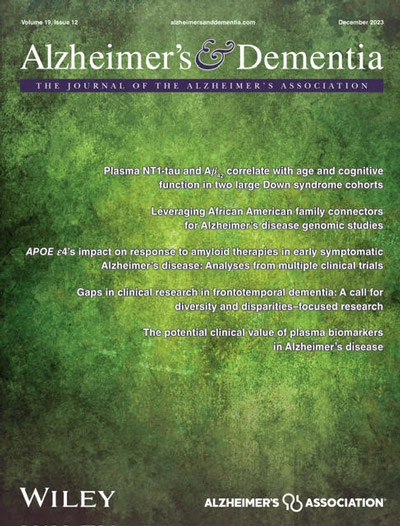Unraveling temporal patterns of diagnostic markers and comorbidities in Alzheimer's disease: Insights from large-scale data
Abstract
INTRODUCTION
Comorbid conditions associated with Alzheimer's disease (AD) are poorly understood regarding timing and potential impact on disease onset and progression.
METHODS
Medical Information Mart for Intensive Care-IV electronic health records from 2008 to 2019 were examined. The study identified 2527 AD patients (34.9% male, mean age 80.27 years) among 299,712 patients. We examined the timing of 12 cardiovascular and metabolic diseases relative to AD diagnosis. Data from the National Alzheimer's Coordinating Center validated the findings.
RESULTS
Hypertension was the most common comorbidity, diagnosed 1.09 years before AD. Depression was the only comorbidity diagnosed after AD start, 0.16 years on average. AD patients had greater rates of hypertension, hypercholesterolemia, and depression compared to the general population.
DISCUSSION
The findings emphasize early detection and therapy of AD-related comorbidities, notably cardiovascular and metabolic diseases. The temporal link between these diseases and AD suggests opportunities for preventive strategies and improved care pathways.
Highlights
- Temporal analysis of comorbidities: The study reveals hypertension and hyperlipidemia as leading precursors to AD, typically diagnosed 1 to 1.3 years prior to AD onset, while depression emerges predominantly after diagnosis.
- Unique data integration: Large-scale datasets from MIMIC-IV (n = 299,712) and NACC (n = 51,836) were leveraged to identify chronological patterns in 12 key comorbid conditions relative to AD diagnosis.
- Sex- and age-specific insights: AD prevalence peaks at 80 to 86 years, with females exhibiting higher rates of LOAD compared to males.
- Depression as a post-diagnostic marker: Unlike other comorbidities, depression's post-diagnostic mean onset (0.16 years after AD diagnosis) highlights the need for targeted mental health interventions in AD patients.
- Implications for early detection: Findings suggest that managing hypertension, hyperlipidemia, and other modifiable conditions in midlife may delay or reduce the risk of AD development.
- Comorbidity variability across cohorts: Hypertension and hypercholesterolemia showed significantly higher prevalence in the NACC cohort compared to MIMIC-IV, reflecting potential dataset-specific biases or regional healthcare differences.
- Future research directions: Advocates for longitudinal, multiethnic, and global studies to refine early diagnostic criteria and explore preventive strategies tailored to comorbid conditions.


 求助内容:
求助内容: 应助结果提醒方式:
应助结果提醒方式:


